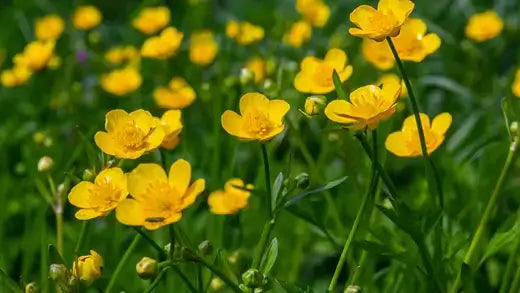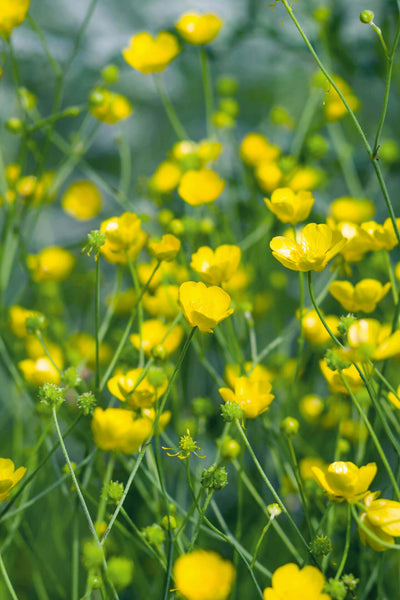The world of flora is replete with an astonishing array of plants, each with unique characteristics and captivating stories. The Ranunculus plant, scientifically known as Ranunculus spp., stands out for its vibrant colors, intricate blooms, and rich botanical history. This article takes an in-depth look at the Ranunculus plant, exploring its taxonomy, morphology, habitat, cultivation, cultural significance, and more.
Taxonomy and Classification of Ranunculus Plant
The Ranunculus genus is a part of the Ranunculaceae family, commonly called the Buttercup family. This family encompasses a diverse group of flowering plants, including both herbaceous and woody species. The Ranunculus genus comprises around 600 species, making it a significant and diverse group within the botanical world. The name "Ranunculus" is derived from the Latin word "rānunculus," meaning "little frog," likely due to the wet habitats in which many species of this genus thrive.
Morphology and Characteristics of Ranunculus Plant
The Ranunculus plant exhibits various morphological features depending on the species. However, several common characteristics define the genus. These include alternate, compound leaves, often lobed or divided, typically characterized by their toothed margins. The flowers of Ranunculus plants are a standout feature, boasting numerous petals that are usually glossy and vividly colored.
Habitat and Distribution
Ranunculus plants are found in diverse habitats across the globe, from temperate regions to alpine meadows, marshes, woodlands, and even rocky slopes. Their adaptability to various environments has allowed them to thrive in multiple conditions. The genus is distributed across North America, Europe, Asia, and parts of Africa, showcasing its ability to inhabit both the northern and southern hemispheres.
Cultivation and Varieties
The Ranunculus plant has captured the hearts of gardeners and horticulturists, leading to its widespread cultivation for ornamental and commercial purposes. One of the most popular cultivated species is the Persian buttercup (Ranunculus asiaticus), known for its large, double-petaled blooms and stunning color palette.
These cultivars often grace gardens, floral arrangements, and events with their vibrant presence.
Cultivating Ranunculus plants can be a rewarding but delicate endeavor. These plants prefer well-draining soil and a sunny location. They are typically grown from corms, underground storage structures similar to bulbs. Corms are planted in the fall, allowing them to establish their root systems before winter. With proper care, including regular watering and protection from extreme temperatures, Ranunculus plants can produce a breathtaking display of blooms in the spring.
Cultural and Symbolic Significance
The Ranunculus plant has historically garnered various cultural and symbolic meanings. The Ranunculus is often associated with charm and attractiveness in the language of flowers or floriography. Its vibrant and layered petals are seen as a representation of layers of emotions or aspects of a person's personality.
In different cultures, Ranunculus plants have held diverse meanings. In some regions, they symbolize radiance and attractiveness; in others, they may be associated with sincerity and virtue. The Ranunculus plant has also been used in traditional medicine for its potential healing properties. However, caution should be exercised due to compounds that can be toxic if ingested.
Challenges and Future Prospects
Despite its beauty and cultural significance, cultivating Ranunculus plants can pose challenges. These include susceptibility to certain pests and diseases and sensitivity to improper growing conditions. Moreover, in regions where these plants are not native, they can become invasive and threaten native plant populations.
Looking ahead, the prospects for Ranunculus plants remain promising. Continued cultivation efforts, research into pest and disease management, and responsible gardening practices will contribute to the preservation and enjoyment of these captivating flora.
The Beneficial Aspects of the Ranunculus Plant
The Ranunculus plant, renowned for its stunning beauty and vibrant blooms, offers more than just visual delight. Beneath its captivating exterior, this plant harbors a range of benefits that extend to various aspects of our lives. From ecological contributions to medicinal potential, the Ranunculus plant proves to be a valuable asset. Here, we explore some of the key benefits that this remarkable plant has to offer.
Ornamental Beauty and Aesthetics: One of the most apparent benefits of the Ranunculus plant lies in its decorative value. The plant's lush, multi-layered petals in a kaleidoscope of colors make it a sought-after choice for gardens, landscapes, and floral arrangements. Its presence can transform spaces, adding a touch of elegance, charm, and a sense of celebration. Its aesthetic appeal contributes significantly to creating visually appealing environments that uplift and rejuvenate.
Biodiversity Support
Ranunculus plants contribute to biodiversity by providing habitats and resources for various insect species. The nectar-rich flowers attract pollinators such as bees, butterflies, and other insects, playing a crucial role in pollinating surrounding plants. By supporting a diverse range of pollinators, Ranunculus plants indirectly aid in the reproduction and survival of many other plant species, thus contributing to the overall health of ecosystems.
Potential Medicinal Properties
Certain species of the Ranunculus genus have been investigated for their potential medicinal properties. Historically, traditional medicine systems have used extracts from these plants for various purposes, including treating skin conditions, relieving pain, and aiding digestion. However, it's important to note that some Ranunculus species contain compounds that can be toxic if consumed, and any potential medicinal use should be approached with caution and under the guidance of qualified professionals.
Educational Value
The Ranunculus plant presents an excellent educational opportunity. Its diverse species, varied morphologies, and intriguing life cycle can be a valuable teaching tool for botany and horticulture. Studying Ranunculus plants' growth patterns, adaptations, and ecological interactions can provide insights into broader environmental principles and the interconnectedness of different plant species within ecosystems.
Cultural and Symbolic Significance
Beyond their aesthetic and ecological benefits, Ranunculus plants hold cultural and symbolic significance in various societies. These symbols can represent beauty, charm, radiance, and other positive qualities, making them popular choices for gifting on special occasions. The use of Ranunculus blooms in ceremonies, festivals, and celebrations further reinforces their cultural importance.
Floral Industry and Economic Impact
The ornamental value of Ranunculus plants extends to the floral industry, where their blooms are highly sought after for bouquets, arrangements, and event decorations. Ranunculus Flowers' commercial cultivation and trade contribute to local economies and livelihoods of florists, farmers, and distributors. This economic impact underscores the value of the Ranunculus plant in the market and its ability to generate revenue.
Environmental Aesthetics and Mental Well-being
The presence of Ranunculus plants in outdoor spaces not only enhances the visual appeal and has positive effects on mental well-being. Natural landscapes with vibrant colors and diverse plant life are known to reduce stress, improve mood, and foster a sense of tranquility. The aesthetic beauty of Ranunculus blooms, combined with at therapeutic benefits of spending time in natural surroundings, creates a holistic positive impact on human health.
Conclusion
The Ranunculus plant's allure lies in its enchanting blooms, rich history, cultural symbolism, and botanical diversity. From its taxonomic classification to its habitat preferences, cultivation methods, and cultural significance, the Ranunculus plant showcases the intricate interplay between nature and human admiration. Whether gracing gardens or adorning floral arrangements, the Ranunculus plant continues to capture hearts and imaginations worldwide, reminding us of the natural beauty of the natural world.


